How institutions structure their data functions is as imperative as the data itself. To achieve a data-driven culture, and enable data-informed decision-making, some institutions are evolving their structures to adapt to the data and analytics needs of their stakeholders.
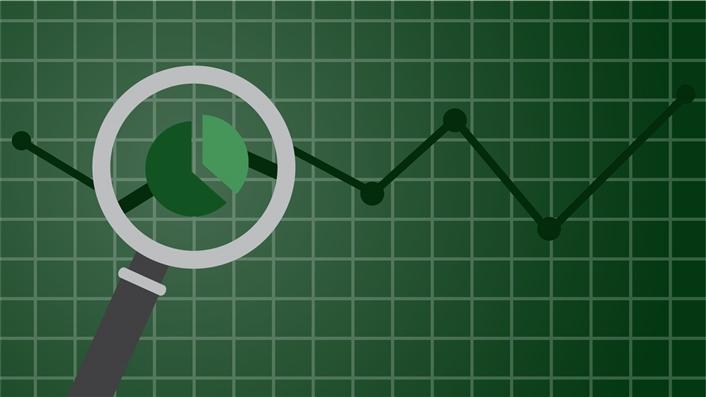
EDUCAUSE is helping institutional leaders, technology professionals, and other staff address their pressing challenges by sharing existing data and gathering new data from the higher education community. This report is based on an EDUCAUSE QuickPoll. QuickPolls enable us to rapidly gather, analyze, and share input from our community about specific emerging topics.Footnote1
The Challenge
Higher education institutions are facing an increasing demand for readily available data and analyses in easily consumable formats.Footnote2 Coupled with a rise in new analytics technologies, this demand is presenting institutions with a chance to make data-informed decisions. For data-informed decision-making to function efficiently and effectively, however, institutions need the personnel and structure that can support these data capabilities. In this QuickPoll, we seek to understand how institutions are organized and staffed to support the use of data and analytics and to consider how the structure of these functions could be improved.
The Bottom Line
While few respondents (25%) believe that the current structure of data functions at their institution is ideal for meeting data and analytics needs, the good news is that these functions are already supported by a majority of institutions (and are prominently located within their organization). Although institutional use of data and analytics has yet to become part of the culture and only a small number of respondents (16%) report that the functions operate collaboratively and cohesively together, institutions are primed to take advantage of the opportunities to structure these functions to meet stakeholders' needs.
The Data: Current State of Data Functions
Most institutions support each data function, but this support differs by FTE size. We asked respondents to report if their institution has one or more staff members dedicated to supporting five data functions:
- Institutional Research: Provides data and conducts research and analysis that supports the institution
- Business Intelligence: Collects, stores, reports, and analyzes data to help institutions make decisions
- Analytics: Analyzes data to gain insight and make informed decisions about complex issues
- Data Governance: Develops processes and methods for managing institutional data
- Academic/Institutional Effectiveness: Facilitates ongoing, integrated, institution-wide planning and evaluation processes
Most respondents (97%) indicated that their institution has one or more staff members dedicated to supporting at least one of these five functions. As shown in figure 1, Institutional Research (IR) was the most frequently selected function—by more than 90% of respondents. Although Business Intelligence (BI), Analytics, Data Governance, and Academic/Institutional Effectiveness are less widespread, they are still prominent features at institutions. For each data function at their institution, respondents were also asked whether each function is centralized (staff are organized within the same office or department) or decentralized (staff are organized in different offices or departments across the institution). Three functions are mostly centralized: Institutional Research, Data Governance, and Academic/Institutional Effectiveness. Business Intelligence and Analytics were indicated as being mostly decentralized.
Does your institution have one or more staff members dedicated to supporting the following data-related functions?
Please indicate whether each function is centralized (staff are organized within the same office or department) or decentralized (staff are organized in different offices or departments across the institution):
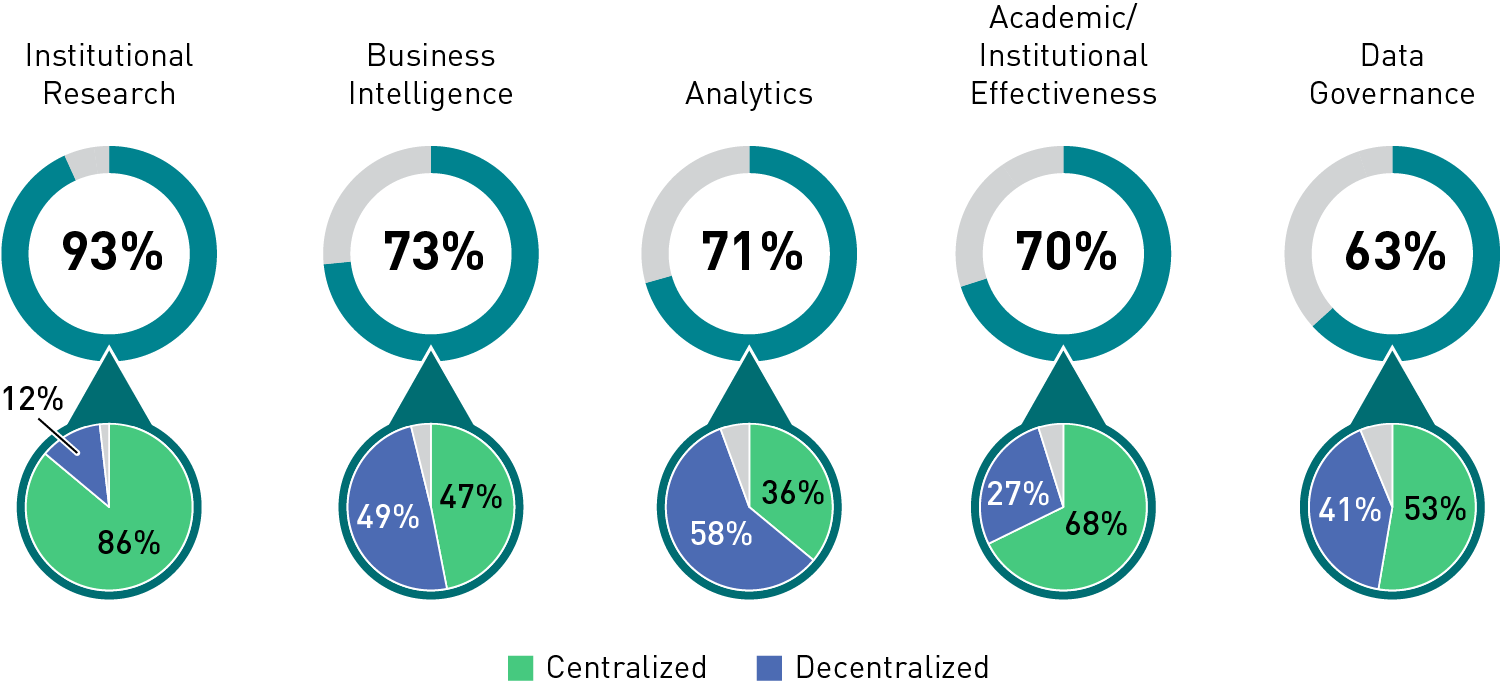
The percentage of respondents who indicated that their institution has staff members to support each function generally increases as FTE size increases. Compared with institutions that have an FTE of 15,000 or more, institutions that have an FTE of less than 2,000 were less likely to report that they have staff supporting each function:
- Institutional Research: 100% (FTE 15,000 or more) versus 58% (FTE less than 2,000)
- Business Intelligence: 88% versus 33%
- Analytics: 83% versus 50%
- Data Governance: 75% versus 17%
- Academic/Institutional Effectiveness: 75% versus 67%
These observed differences could be explained by differences in types and amounts of resources available at these institutions.
Most centralized data functions live in technology units and are directly overseen by senior leadership. For centralized functions, respondents were asked to indicate where each data function is located at their institution. The top three selected locations were technology, data and analytics, and academic units. Institutional Research is found primarily in data and analytics units (30%) and academic units (30%), while Business Intelligence and Data Governance are most often located in technology units (58% and 48%, respectively). Unsurprisingly, the Analytics function is organized within data and analytics units more than a third of the time (37%) but is closely followed by technology units (35%). Academic/Institutional Effectiveness functions are primarily located in academic units (47%). (See figure 2.)
In which of the following areas are the data-related functions located at your institution?

Those respondents at institutions with centralized functions were also asked to indicate which senior-most position directly oversees each function. Of the five functions, four (Institutional Research, Analytics, Data Governance, and Academic/Institutional Effectiveness) are most often directly led by a Vice President / Senior Vice President (VP/SVP). The Business Intelligence function most often reports to a manager or director, followed closely by VP/SVP. (See figure 3.)
Please indicate which senior-most position directly oversees each of the following data-related functions:
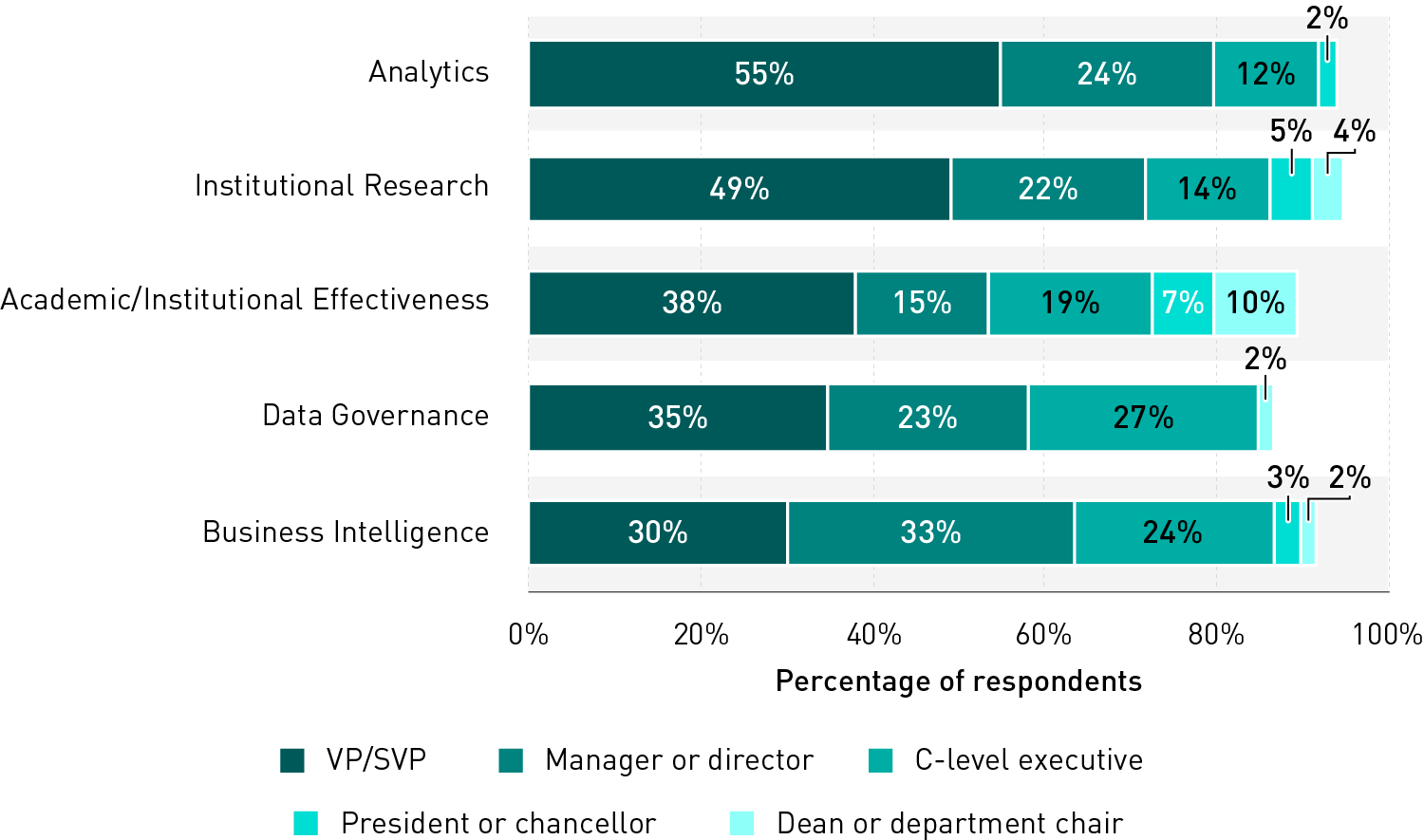
The Data: Efficacy, Operations, and Use
Current structures of data functions have yet to realize their full potential. Overall, just 25% of respondents believe that the current structure of data functions at their institution—who the function reports to, in which area the function is located, and whether the function is centralized or decentralized—is ideal for meeting the data and analytics needs of the institution (see figure 4).
Thinking about how these data-related functions are structured at your institution, do you believe the current structure is ideal for meeting the data and analytics needs of your institution?
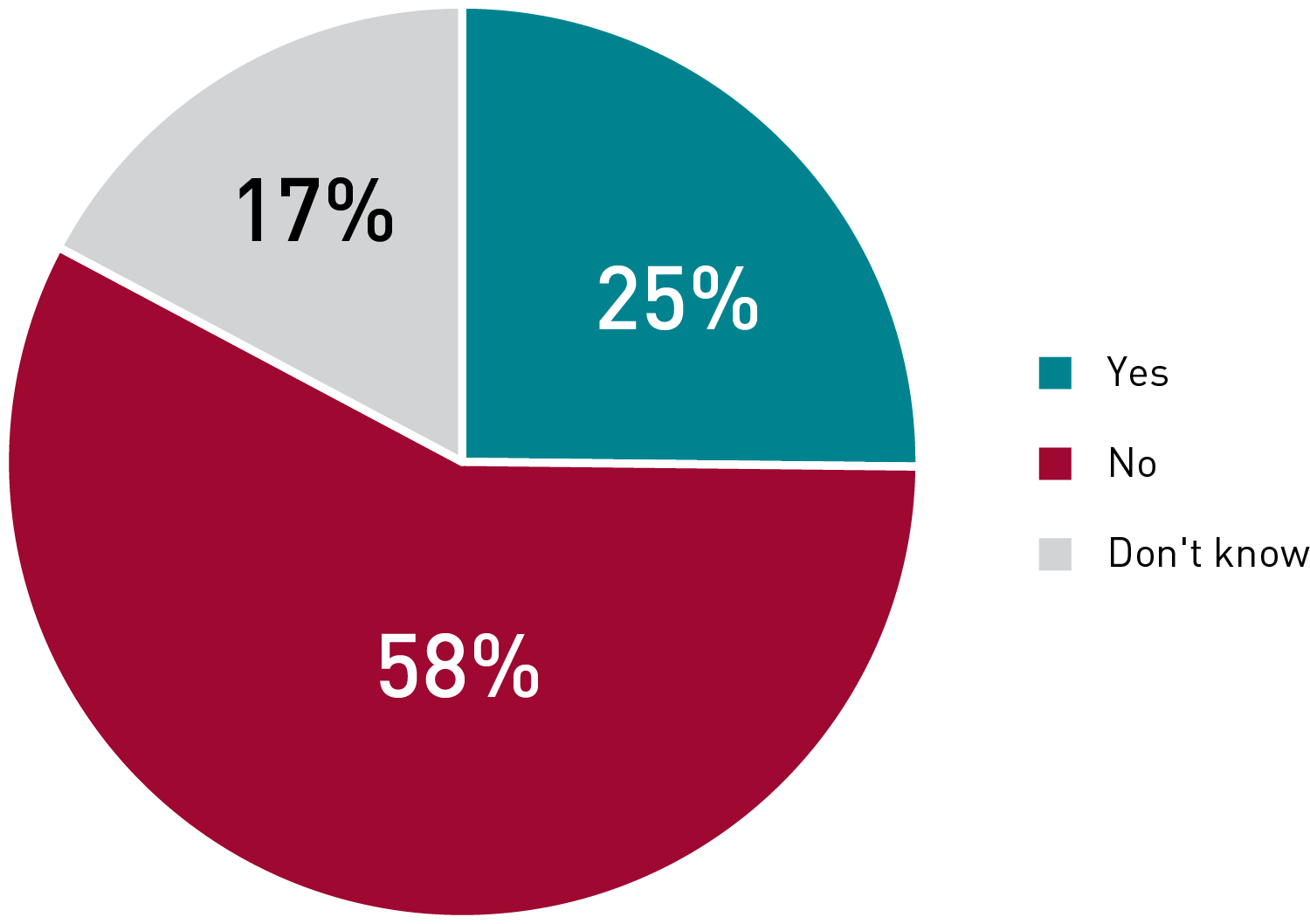
Respondents who believe the current structure of their institution is ideal for meeting data and analytics needs were asked to describe the ways in which the current structure has been effective.Footnote3 Respondents (n=21) described cultural characteristics such as having a shared mission or approach across functions, and they cited the benefits to the overall institution resulting from the current structure.
- "Centralizing the analytics, research, and data engineering departments has helped standardize results and streamline workflows."
- "Shared responsibility is proving to be more resilient than the previous, specialized organization."
- "As a unit reporting directly to the university's president, our team has flexibility and the necessary authority to collect, align, and distribute data for executive decision support, strategic planning, and executive communications."
- "Collaboration and discussions between and within departments have helped to enrich data and analytical presentations."
Respondents who do not believe the current structure of their institution is ideal for meeting data and analytics needs were asked to describe the ways in which the current structure does not meet these needs. The themes among those who responded (n=65) centered around challenges related to a decentralized structure: duplication of efforts, misaligned mission and budget to support the function, lack of a standardized data strategy, and limited collaboration.
- "Data strategy needs to be centralized. Each decentralized unit has its own strategy, which causes silos and units becoming territorial."
- "Central IT doesn't report to the same unit as data and analytics units. This difference creates misalignment of goals and competing priorities, making it hard to get the support for data and analytics that is needed."
- "While there is technical expertise centrally located in the IT department, there is no central party to drive the data needs of other departments actively. We function in a relatively passive manner."
- "Lack of centralized mission and purpose about how we use data institutionally has prevented us from determining the best ways to support data use on campus."
- "Analysts in IR and IE are in different divisions. Data strategy is being conducted in those divisions with almost no technical guidance or effective oversight from IT. Additionally, decentralized BI has led to numerous sources of truth and an extremely disorganized approach to setting BI priorities."
Current structures are less than ideal, particularly for decentralized functions. Among centralized data functions, 34% to 57% of respondents believe that the current structure of the institution does not meet data and analytics needs. In contrast, among decentralized data functions, 38% to 71% of respondents do not believe their current structure is ideal to meet the data and analytics needs of the institution. (See figure 5.)
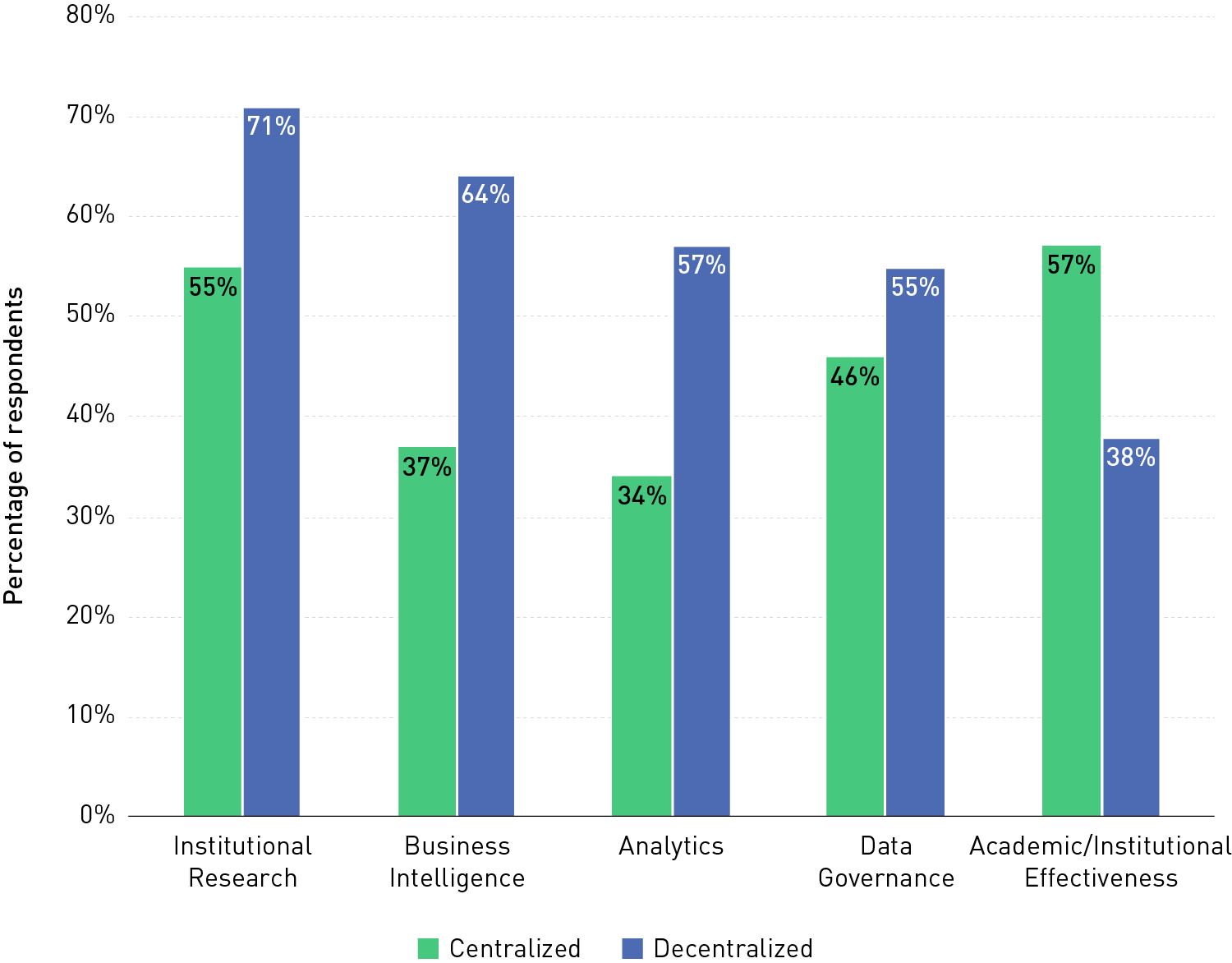
Most data functions are aligned in practice, yet few institutions have scaled their use. When asked how the data functions at their institution operate, more than two-thirds of respondents (68%) reported that the functions are somewhat aligned and collaborative but still disparate. Remaining respondents were split between opposite ends of the spectrum: 16% indicated that the functions operate collaboratively and cohesively together; 15% reported that each one operates independently.
When it comes to putting data and analytics to use, just 10% of respondents reported that use of analytics has scaled across their institution and that data is part of their culture. While a majority of respondents (59%) indicated that their institution has pockets of excellence that use analytics, nearly one-third (31%) reported that use of data and analytics is just emerging and beginning to evolve at their institution. (See figure 6.)
Which of the following reflects the degree to which your institution uses data and analytics?
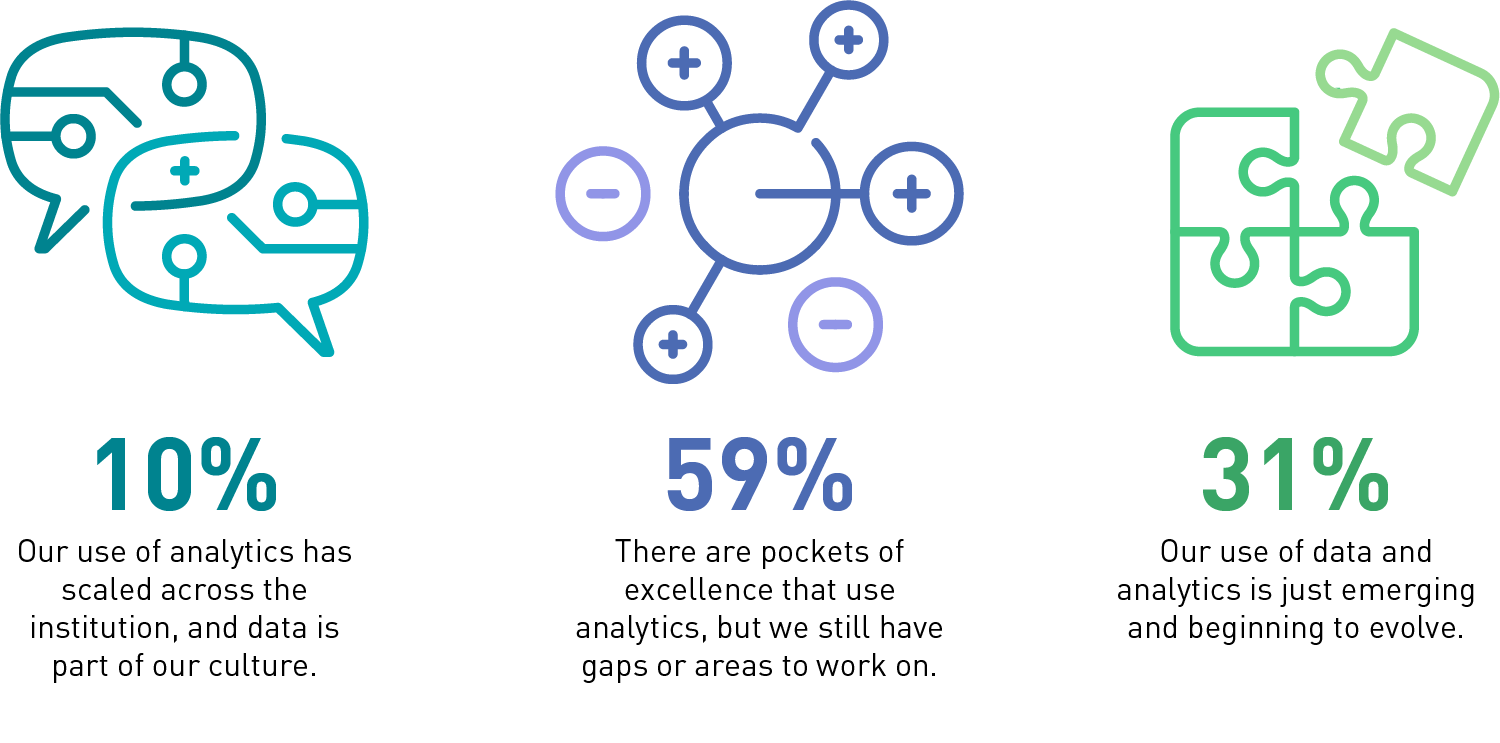
The Data: (Re)organizing Data Functions
To (re)organize or to not (re)organize, that is the question. Institutional leaders are beginning to consider ways to improve the structure of these data functions at their institution. More than one-third of respondents (37%) said that their institution has recently restructured one or more of its data functions, more than half (57%) said their institution has not restructured, and a small percentage don't know (6%). Of those respondents whose institutions have recently restructured (n=41), their reasons for doing so mostly include the creation of a new role, position, office, or department; reprioritization by the institution of data needs and functionality; and mergers between roles, positions, offices, and/or departments.
Additionally, respondents were asked if their institution is considering restructuring one or more of its data functions in the near future. Twenty-eight percent of respondents reported that they are considering, and 32% reported that they are not considering. Most respondents stated they don't know (41%). For those respondents who reported that their institution is considering restructuring, the reasons include siloed-systems, processes, or departments; reprioritization by the institution of data needs and functionality; and the inability to fully utilize data. One comment in particular summarizes well the impetus for change: "To bring together all of the functions related to analytics and data services to provide institution-wide focus on using data to provide actionable insights. We've been data rich but information and insight poor; bringing the groups together as a centralized service organization will (hopefully) provide us with the ability to develop analytics and metrics that cut across institutional units."
Common Challenges
Haves and have-nots play a role when it comes to data functions and institution size. Although support for at least one data function was found at most institutions, differences in support availability exist between FTE sizes. This is likely due to the types and amounts of resources available at institutions.
Current (decentralized) structures are not ideal. While the area in which the function is organized and to whom the function reports are equally important components in how functions are structured, whether the function is centralized or decentralized plays a much larger role when determining if the structure is ideal for meeting the data and analytics needs of the institution. Decentralized functions face a number of operational challenges that centralized units do not.
Operating cross-functionally is an effort-in-progress. Regardless of the current structure, few institutions have achieved collaboration and cohesiveness across data functions. Even those respondents who reported some alignment and collaboration still operate disparately and are working through how to develop a unified data strategy.
Promising Practices
Senior leadership often leads each function. Data functions that are directly overseen by senior leaders (President, C-level, VP/SVP) referenced the visibility, access, and authority they have as contributors to enabling their teams to successfully meet the data and analytics needs of their institution.
Use of data and analytics continues to evolve. Although few institutions have scaled their use of analytics and have yet to see data use become part of their culture, most institutions have established pockets of excellence that use analytics while continuing to address data gaps in other areas. Where the use of data and analytics is just emerging and beginning to evolve, the opportunity to examine how the data functions are (or will be) structured and how they operate cross-functionally will help to enable earlier and broader successes.
EDUCAUSE Resources
EDUCAUSE Review: Dave Weil, Casey Kendall and Rob Snyder, "A Modern Framework for Institutional Analytics"
EDUCAUSE Library:
- Analytics
- Business Intelligence
- 2022 EDUCAUSE Horizon Report | Data and Analytics Edition
- Analytics Institutional Self Assessment
AIR, EDUCAUSE, and NACUBO: Joint Statement on Analytics
CONNECT Community Groups:
All QuickPoll results can be found on the EDUCAUSE QuickPolls web page. For more information and analysis about higher education IT research and data, please visit the EDUCAUSE Review EDUCAUSE Research Notes channel, as well as the EDUCAUSE Research web page.
Notes
- QuickPolls are less formal than EDUCAUSE survey research. They gather data in a single day or two, instead of over several weeks, and allow timely reporting of current issues. This poll was conducted on February 20–21, 2023, consisted of 18 questions, and resulted in 177 complete responses. Poll invitations were sent to participants through the EDUCAUSE Connect platform to groups focused on IT leadership, developing and executing data strategy, and student success analytics. We are not able to associate responses with specific institutions. Our sample represents a range of institution types and FTE sizes, and most respondents (90%) represented U.S. institutions. Jump back to footnote 1 in the text.
- See the 2022 EDUCAUSE Horizon Report | Data and Analytics Edition, July 19, 2022. Jump back to footnote 2 in the text.
- Direct quotes have been lightly edited for readability. Jump back to footnote 3 in the text.
Ashley Caron is Researcher at EDUCAUSE.
Jaclyn Smith is Research Data Analyst at EDUCAUSE.
© 2023 Ashley Caron and Jaclyn Smith. The text of this work is licensed under a Creative Commons BY-NC-ND 4.0 International License.
